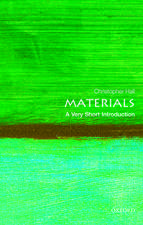Non-Reciprocal Materials and Systems: An Engineering Approach to the Control of Light, Sound, and Heat
Autor Prabhakar Bandaruen Limba Engleză Paperback – 24 ian 2024
This book is suitable for researchers in materials science, condensed matter physics, electrical, mechanical, and structural engineering, and technologists aiming for better control of non-electronic physical phenomena.
- Provides information on how to use specific features in new and artificial materials for the control of sound, light and heat
- Explores dimensional considerations such as surface material phenomena that can be decoupled from bulk materials or the inside of a material
- Discusses new device concepts and related technologies such as energy sources, isolators, and diodes involving energy confinement
Preț: 1124.22 lei
Preț vechi: 1371.01 lei
-18% Nou
Puncte Express: 1686
Preț estimativ în valută:
215.22€ • 224.56$ • 180.41£
215.22€ • 224.56$ • 180.41£
Carte disponibilă
Livrare economică 20 februarie-06 martie
Livrare express 05-11 februarie pentru 41.97 lei
Preluare comenzi: 021 569.72.76
Specificații
ISBN-13: 9780323999816
ISBN-10: 0323999816
Pagini: 474
Ilustrații: 100 illustrations (80 in full color)
Dimensiuni: 152 x 229 x 26 mm
Greutate: 0.77 kg
Editura: ELSEVIER SCIENCE
ISBN-10: 0323999816
Pagini: 474
Ilustrații: 100 illustrations (80 in full color)
Dimensiuni: 152 x 229 x 26 mm
Greutate: 0.77 kg
Editura: ELSEVIER SCIENCE
Cuprins
1. Nonreciprocity versus asymmetry
2. Microscopic processes and related energy flow leading to
nonreciprocity
3. Energy propagation in media
4. The arguments for reciprocity in electrodynamics and
associated phenomena
5. Real-space and energy-space features of materials systems
6. Considerations of nonreciprocity in electrical and optical
systems
7. The manifestation of nonreciprocity, in dynamical systems
8. Exploring new avenues for the manifestation of reciprocal
phenomena
9. Applications of nonreciprocity to practical devices
2. Microscopic processes and related energy flow leading to
nonreciprocity
3. Energy propagation in media
4. The arguments for reciprocity in electrodynamics and
associated phenomena
5. Real-space and energy-space features of materials systems
6. Considerations of nonreciprocity in electrical and optical
systems
7. The manifestation of nonreciprocity, in dynamical systems
8. Exploring new avenues for the manifestation of reciprocal
phenomena
9. Applications of nonreciprocity to practical devices






















